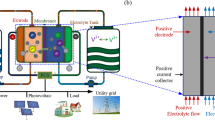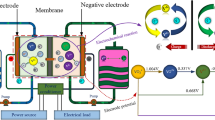Abstract
This paper presents topology optimization for the design of flow fields in vanadium redox flow batteries (VRFBs), which are large-scale storage systems for renewable energy resources such as solar and wind power. It is widely known that, in recent VRFB systems, one of the key factors in boosting charging or discharging efficiency is the design of the flow field around carbon fiber electrodes and in flow channels. In this study, topology optimization is applied in order to achieve optimized flow field designs. The optimization problem is formulated as a maximization problem for the generation rate of the vanadium species governed by a simplified electrochemical reaction model. A typical porous model is incorporated into the optimization problem for expressing the carbon fiber electrode; furthermore, a mass transfer coefficient that depends on local velocity is introduced. We investigate the dependencies of the optimized configuration with respect to the porosity of the porous electrode and the pressure loss. Results indicate that patterns of interdigitated flow fields are valid designs for VRFBs.












Similar content being viewed by others
References
Aaron D, Liu Q, Tang Z, Grim G, Papandrew A, Turhan A, Zawodzinski T, Mench M (2012) Dramatic performance gains in vanadium redox flow batteries through modified cell architecture. J Power Sources 206:450–453
Alexandersen J, Aage N, Andreasen CS, Sigmund O (2014) Topology optimisation for natural convection problems. Int J Numer Meth Fluids 76(10):699–721
Alexandersen J, Sigmund O, Aage N (2016) Large scale three-dimensional topology optimisation of heat sinks cooled by natural convection. Int J Heat Mass Trans 100:876–891
Andreasen CS, Gersborg AR, Sigmund O (2009) Topology optimization of microfluidic mixers. Int J Numer Meth Fluids 61(5):498–513
Behrou R, Lawry M, Maute K (2017) Level set topology optimization of structural problems with interface cohesion. Int J Numer Meth Eng. doi:10.1002/nme.5540
Bendsøe MP, Kikuchi N (1988) Generating optimal topologies in structural design using a homogenization method. Comput Methods Appl Mech Eng 71(2):197–224
Bendsøe MP, Sigmund O (2003) Topology optimization: theory, methods and applications. Springer, New York
Borrvall T, Petersson J (2003) Topology optimization of fluids in Stokes flow. Int J Numer Meth Fluids 41(1):77–107
Coffin P, Maute K (2016) A level-set method for steady-state and transient natural convection problems. Struct Multidisc Optim 53(5):1047–1067
Cunha Á, Martins J, Rodrigues N, Brito F (2015) Vanadium redox flow batteries: a technology review. Int J Energy Res 39(7):889–918
Deaton JD, Grandhi RV (2014) A survey of structural and multidisciplinary continuum topology optimization: post 2000. Struct Multidisc Optim 49(1):1–38
Delanghe B, Tellier S, Astruc M (1990) Mass transfer to a carbon or graphite felt electrode. Electrochim Acta 35(9):1369–1376
Deng Y, Liu Z, Zhang P, Liu Y, Gao Q, Wu Y (2012) A flexible layout design method for passive micromixers. Biomed Microdevices 14(5):929–945
Hughes TJ, Mallet M (1986) A new finite element formulation for computational fluid dynamics: III. The generalized streamline operator for multidimensional advective-diffusive systems. Comput Methods Appl Mech Eng 58(3):305–328
Kawamoto A, Matsumori T, Yamasaki S, Nomura T, Kondoh T, Nishiwaki S (2011) Heaviside projection based topology optimization by a PDE-filtered scalar function. Struct Multidisc Optim 44(1):19–24
Koga AA, Lopes ECC, Nova HFV, de Lima CR, Silva ECN (2013) Development of heat sink device by using topology optimization. Int J Heat Mass Trans 64:759–772
Kreissl S, Maute K (2012) Levelset based fluid topology optimization using the extended finite element method. Struct Multidisc Optim 46(3):311–326
Kubo S, Yaji K, Yamada T, Izui K, Nishiwaki S (2017) A level set-based topology optimization method for optimal manifold designs with flow uniformity in plate-type microchannel reactors. Struct Multidisc Optim 55 (4):1311–1327
Lazarov BS, Sigmund O (2011) Filters in topology optimization based on Helmholtz-type differential equations. Int J Numer Meth Eng 86(6):765–781
Lin S, Zhao L, Guest JK, Weihs TP, Liu Z (2015) Topology optimization of fixed-geometry fluid diodes. J Mech Des 137(8):081402
Matsumori T, Kondoh T, Kawamoto A, Nomura T (2013) Topology optimization for fluid–thermal interaction problems under constant input power. Struct Multidisc Optim 47(4):571–581
Okkels F, Bruus H (2007) Scaling behavior of optimally structured catalytic microfluidic reactors. Phys Rev E 75(1):016301
Olesen LH, Okkels F, Bruus H (2006) A high-level programming-language implementation of topology optimization applied to steady-state Navier-Stokes flow. Int J Numer Meth Fluids 65(7):975–1001
Othmer C (2008) A continuous adjoint formulation for the computation of topological and surface sensitivities of ducted flows. Int J Numer Meth Fluids 58(8):861–877
Rychcik M, Skyllas-Kazacos M (1988) Characteristics of a new all-vanadium redox flow battery. J Power Sources 22(1):59–67
Schäpper D, Lencastre Fernandes R, Lantz AE, Okkels F, Bruus H, Gernaey KV (2011) Topology optimized microbioreactors. Biotechnol Bioeng 108(4):786–796
Schmal D, Van Erkel J, Van Duin P (1986) Mass transfer at carbon fibre electrodes. J Appl Electrochem 16(3):422–430
Shah A, Watt-Smith M, Walsh F (2008) A dynamic performance model for redox-flow batteries involving soluble species. Electrochim Acta 53(27):8087–8100
Sigmund O, Maute K (2013) Topology optimization approaches. Struct Multidisc Optim 48(6):1031–1055
Tezduyar TE, Mittal S, Ray S, Shih R (1992) Incompressible flow computations with stabilized bilinear and linear equal-order-interpolation velocity-pressure elements. Comput Methods Appl Mech Eng 95(2):221–242
Tomadakis MM, Robertson TJ (2005) Viscous permeability of random fiber structures: comparison of electrical and diffusional estimates with experimental and analytical results. J Compos Mater 39(2):163–188
Tsushima S, Suzuki T (2016) Modeling and simulation of an interdigitated vanadium redox flow battery with interfacial mass transfer resistance. The First Pacific-Rim Thermal Engineering Conference, PRTEC-15318
Wang F, Lazarov BS, Sigmund O (2011) On projection methods, convergence and robust formulations in topology optimization. Struct Multidisc Optim 43(6):767–784
Xu Q, Zhao T, Leung P (2013) Numerical investigations of flow field designs for vanadium redox flow batteries. Appl Energy 105:47–56
Xu Q, Zhao T, Zhang C (2014) Performance of a vanadium redox flow battery with and without flow fields. Electrochim Acta 142:61–67
Yaji K, Yamada T, Yoshino M, Matsumoto T, Izui K, Nishiwaki S (2014) Topology optimization using the lattice Boltzmann method incorporating level set boundary expressions. J Comput Phys 274:158–181
Yaji K, Yamada T, Kubo S, Izui K, Nishiwaki S (2015) A topology optimization method for a coupled thermal–fluid problem using level set boundary expressions. Int J Heat Mass Trans 81:878–888
Yaji K, Yamada T, Yoshino M, Matsumoto T, Izui K, Nishiwaki S (2016) Topology optimization in thermal-fluid flow using the lattice Boltzmann method. J Comput Phys 307:355–377
You D, Zhang H, Chen J (2009) A simple model for the vanadium redox battery. Electrochim Acta 54 (27):6827–6836
Zheng Q, Zhang H, Xing F, Ma X, Li X, Ning G (2014) A three-dimensional model for thermal analysis in a vanadium flow battery. Appl Energy 113:1675–1685
Acknowledgements
This work was supported by JSPS KAKENHI Grant Number 16H06935 and by the Japan Science and Technology Agency (JST), Precursory Research for Embryonic Science and Technology (PRESTO).
Author information
Authors and Affiliations
Corresponding author
Appendix: Dimensionless form
Appendix: Dimensionless form
To simplify the numerical implementation, the governing equations (3), (7), and (8) are replaced with dimensionless equations as follows:
where the asterisk represents dimensionless variables defined using a characteristic length L, a characteristic speed U, and the inlet concentration of vanadium c in as follows:
The Reynolds number, R e, and the Pélet number, P e, are respectively given by
In the numerical examples, the characteristic length L is defined as the inlet width. It is noted that the characteristic speed U cannot be defined using the magnitude of the inlet velocity since the pressure loss is fixed in this paper. According to previous research (Yaji et al. 2015), U can be defined using the pressure loss as follows:
where Δp is the dimensional pressure loss, and thus U has the same units as velocity.
Rights and permissions
About this article
Cite this article
Yaji, K., Yamasaki, S., Tsushima, S. et al. Topology optimization for the design of flow fields in a redox flow battery. Struct Multidisc Optim 57, 535–546 (2018). https://doi.org/10.1007/s00158-017-1763-8
Received:
Revised:
Accepted:
Published:
Issue Date:
DOI: https://doi.org/10.1007/s00158-017-1763-8




